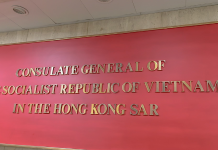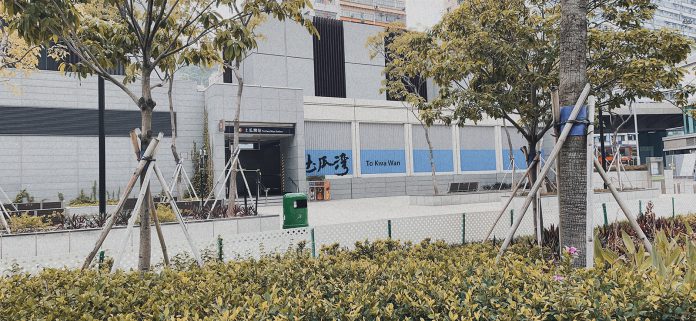Tangled up in redevelopment and a railway launch, To Kwa Wan residents find ways to cope with the changes in the old neighbourhood.
By Kajal Aidasani
Mok Suk-fan, who has been working in To Kwa Wan for 15 years, feels numb about redevelopment plans in the area and the newly launched MTR Tuen Ma Line.
“Shops being acquired, people moving out… all these have been going on for over 10 years. I am so used to all these new establishments such as Grand Waterfront and Sky Tower,” says Mok, who is a clerk and health worker at Kau Pui Lung Elderly Home.
The elderly home is only a three-minute walk from the MTR station opened since June 27. The railway has brought convenience to Mok and families of the elderly home residents by reducing their commuting time and that encourages them to visit the elderly more frequently.
The district in eastern Kowloon houses over 20 elderly homes. Mok says even with the rising rent, none of them plan to relocate. But shops in the neighbourhood are not that lucky.
An area stretching from Chatham Road north to Ma Tau Wai Road was known as the “Furniture Street”, where many shops vended imported furniture of various styles.
Mok says the noise and road blockage caused by the station’s construction, which lasted for nine years, greatly affected the business of the furniture shops.
“Furniture Street” is now packed with shops selling bread, noodles, paper offerings, and many more.
A hardware store and a candy shop which Mok used to visit are closed. The site where they were located is now zoned for urban renewal.
Kalo Supermarket, a grocery shop run by Winnie Wong, is one of those affected by the redevelopment plans. Her shop moved from Hung Fook Street to Yuk Shing Street, in June.
“To be honest, small shops like us are all struggling. We are just waiting for government’s compensation,” Wong says.
Her shop has withstood the test of time in one of Hong Kong’s oldest districts for nearly two decades. It was even featured in a local illustrator, Wai-wai’s postcard set entitled “Vintage Shop with Love” with 19 sketches of shops in 2016.
Wong’s shop was loved by the community – kids used to go for soda drinks after school, and their parents bought daily necessities such as soy sauce. Workers used to gather there for beer, and some spent quality time petting Wong’s cat at the shop.

Wong says her business has not benefited from the newly launched MTR line as her regular customers were relocated to public housing estates in other districts. “I am suffering from 60 per cent business loss, meaning almost no salary,” she says.
The shop owner says her old customers still visit her at the shop. “They come back two to three times a week to take a final glimpse before more buildings get demolished,” she says.
Although she feels attached to the blue-collar neighbourhood, she believes it is time to use an uplift.
“The walls are cracked and leakage is a problem. It is similar to old people like me. When your internal system is malfunctioning, there is no way to repair. You have to change the entire thing,” she says.
The 55-year-old grocery shop owner has spent 30 years in To Kwa Wan. She hopes she can stay in the district for the rest of her life.
“My youth is here,” she sighs. “I will live here anyway, but I am not sure about my shop. The neighbourhood is changing, and all I can do is to go with the flow,” she says.
The neighbourhood is changing, and all I can do is to go with the flow.
Also being subjected to move are ethnic minority residents in the culturally diverse community. According to the 2016 Population By-Census, 10.1 per cent of Kowloon City District’s population, To Kwa Wan included, were ethnic minorities. One of them is Pakistan-born Wasal Khan, owner of Mashaallah Provision Store, who feels uncertain about the future.

He has lived in To Kwa Wan for nine years, and his shop which sells South Asian snacks opened two years ago.
Khan’s home and his shop are both in the redevelopment area. He has signed the relocation agreement but has not been informed about the official vacate date yet.
His monthly rental expense stays at HK$8600 during the years of urban renewal project. But his business has dropped 70 per cent since the redevelopment projects emptied five streets by the end of August.
“Buildings are cleared up. They are all empty places now. Before there was no MTR, and now there is,” 43-year-old Khan says.
Khan thinks he does not benefit from the new MTR line as his old customers are no longer here. They order delivery by telephone once in a while, and do not do shopping as often as before.
According to the Urban Renewal Authority’s website, a “people first, district-based, public participatory” approach should be adopted to carry out urban renewal, with their sustainability aim to support social inclusiveness and social mobility of the underprivileged.

But many of Khan’s friends had to move out of To Kwa Wan and bear higher living costs.
Khan prefers staying in the area and moving both his shop and home to the nearby wet market. “I have many friends here. I have business here, and I have my home here, so it (To Kwa Wan) is special (to me),” he says.
Chloe Au Yee-wing, a social worker in the To Kwa Wan urban renewal social service team, thinks the place is unique for its intangible connections between people.
The renewal projects involving Wing Kwong Street, Kai Ming Street, Hung Fook Street, Yuk Shing Street and Ngan Hon Street came to an end by August, with the last two shops moved out on August 16 and the last resident moved out on August 31.
Au says though many elderly people have resettled in buildings with lifts, they prefer their old homes where they grew up with fond memories.
She recalls seeing the charm of the neighbourhood when she first started working in the area two years ago.
“Walking from one end of the street to another, everyone greeted one another. They gathered around a burst water main and joked about it. They put down shopping bags at shops and retrieved them later at night… Small communities with close ties like these are becoming rare in Hong Kong,” she says.
“Strong community networks may be alien to the young generation. Urban renewal and redevelopment are not just about demolishing, compensating and relocating. The ties between people matter too,” Au adds.
Urban renewal and redevelopment are not just about demolishing, compensating and relocating. The ties between people matter too.
Edited by Kelly Yu
Sub-edited by Reus Lok







































